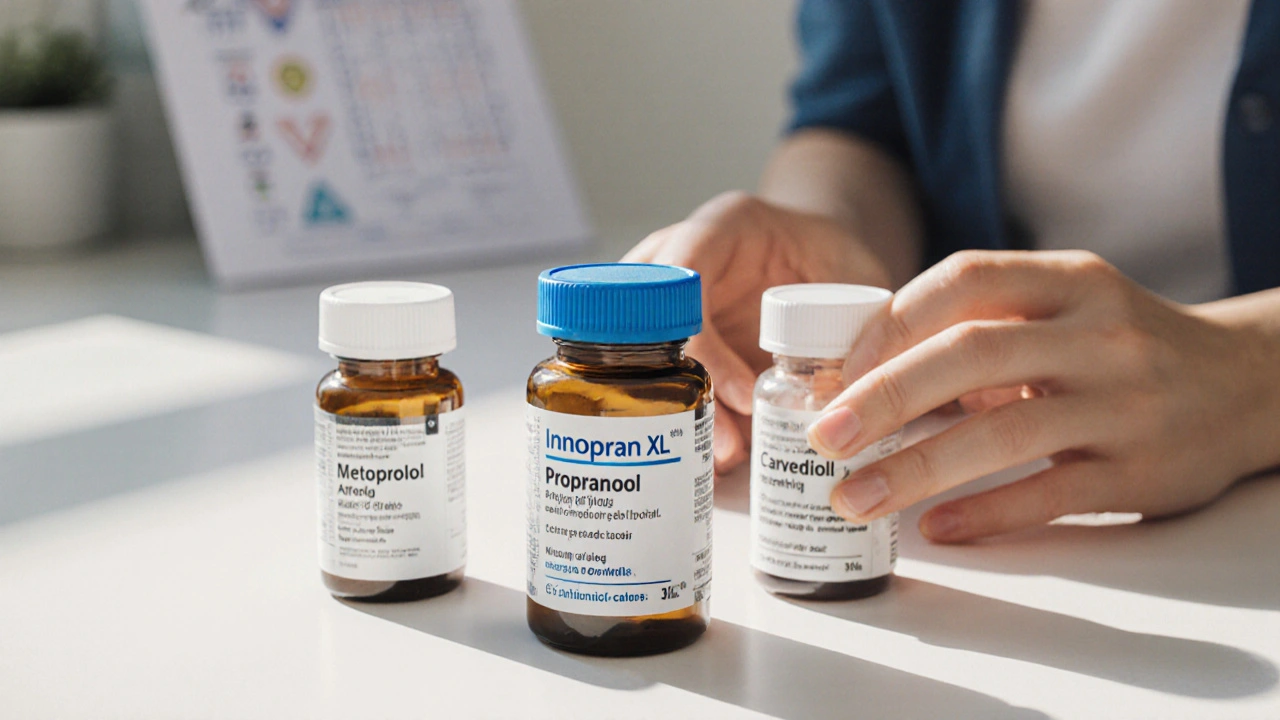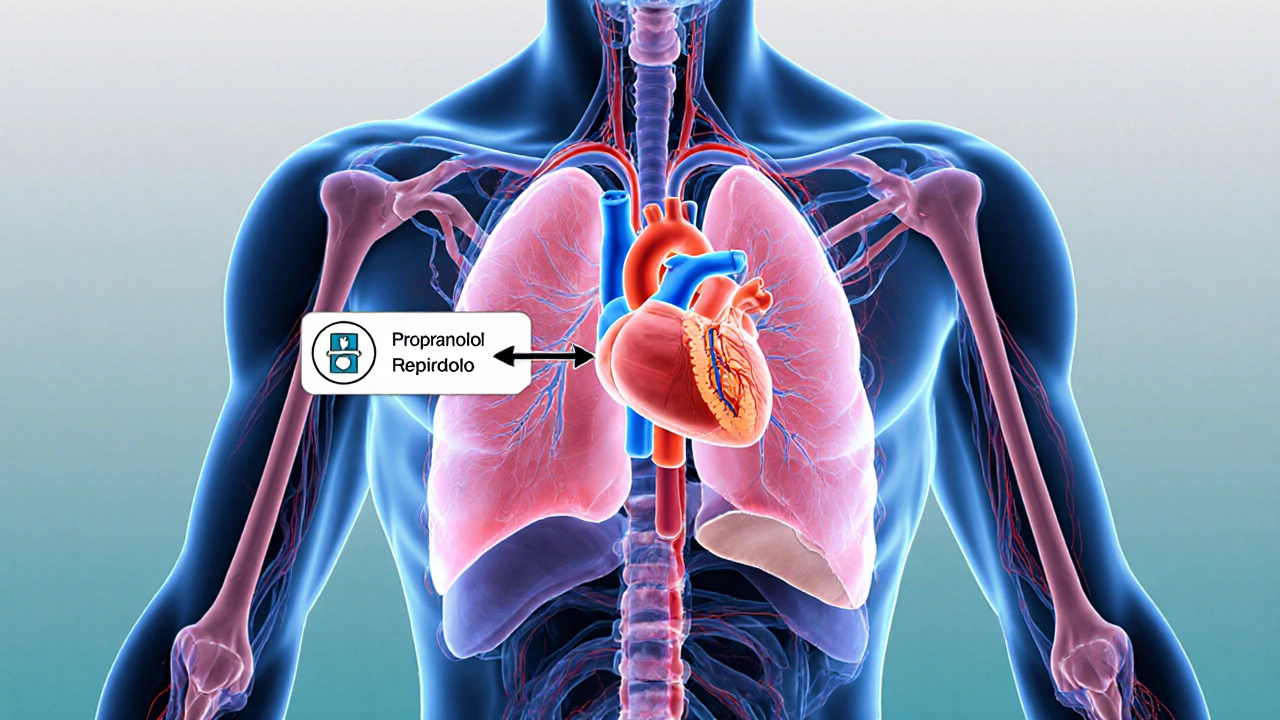Innopran XL (Propranolol) vs. Top Alternatives - Detailed Comparison
 Oct, 8 2025
Oct, 8 2025
Beta-Blocker Comparison Tool
When you’re prescribed Innopran XL (Propranolol), the first question is often, “Is this the best option for me?” You might be weighing other beta‑blockers, wondering about effectiveness, side‑effects, dosing convenience, or cost. This guide lays out the facts so you can compare Propranolol alternatives head‑to‑head and decide which fits your health goals.
Key Takeaways
- InnopranXL is a non‑selective beta‑blocker with a long‑acting formulation, ideal for stable blood‑pressure control and angina.
- Metoprolol and atenolol are cardio‑selective, often preferred for patients with asthma or COPD.
- Carvedilol adds alpha‑blocking activity, useful for heart‑failure patients.
- Cost and dosing frequency can tip the balance-once‑daily InnopranXL vs. twice‑daily alternatives.
- Side‑effect profiles differ: Propranolol may cause more fatigue and cold extremities, while atenolol tends toward fewer central nervous system effects.
What Is Innopran XL?
InnopranXL is the brand name for the extended‑release form of Propranolol, a first‑generation beta‑blocker introduced in the 1960s. It blocks both beta‑1 and beta‑2 receptors, reducing heart rate, contractility, and renin release. The XL formulation releases the drug gradually over 24hours, allowing once‑daily dosing-a convenience many patients appreciate.
Typical indications include hypertension, angina pectoris, arrhythmias, migraine prophylaxis, and essential tremor. Dosage usually starts at 80mg once daily, with a maintenance range of 120‑240mg depending on the condition.
How Propranolol Works
Propranolol binds to adrenergic receptors in the heart, lungs, and blood vessels. By inhibiting the sympathetic response, it lowers cardiac output and reduces the force of contraction, which in turn drops blood pressure. Its non‑selective nature means it also affects beta‑2 receptors in the airways, potentially causing bronchoconstriction-hence the need for caution in asthma patients.

Major Alternatives to Consider
Below are the most common beta‑blockers that clinicians compare against Propranolol. Each has distinct pharmacologic traits that may make it a better fit for specific patients.
Metoprolol
Metoprolol is a cardio‑selective (beta‑1) blocker. It’s often prescribed for hypertension, heart failure, and post‑myocardial infarction therapy. Because it spares beta‑2 receptors, it’s safer for those with mild asthma. Available in immediate‑release (twice daily) and extended‑release (once daily) versions.
Atenolol
Atenolol is another beta‑1 selective agent, known for low lipophilicity, which means fewer central nervous system side‑effects like vivid dreams. It’s commonly used for hypertension and angina, but its short half‑life often requires twice‑daily dosing.
Carvedilol
Carvedilol combines beta‑blocking with alpha‑1 blockade, leading to vasodilation. This dual action makes it a first‑line choice for chronic heart failure and left‑ventricular dysfunction. The trade‑off is a higher incidence of dizziness due to the added vasodilatory effect.
Labetalol
Labetalol is a mixed alpha‑ and beta‑blocker, frequently used in hypertensive emergencies and during pregnancy (where other beta‑blockers may be limited). It offers rapid blood‑pressure reduction but can cause orthostatic hypotension.
Nebivolol
Nebivolol is a newer, highly beta‑1 selective blocker with nitric‑oxide mediated vasodilation. It’s praised for a lower risk of metabolic side‑effects and may improve exercise tolerance in some patients.
Side‑Effect Profiles at a Glance
Side effects often drive the final decision. Below is a concise rundown of common adverse events for each drug.
- Propranolol: fatigue, cold hands/feet, sleep disturbances, bronchospasm in susceptible individuals.
- Metoprolol: bradycardia, mild dizziness, occasional depression.
- Atenolol: insomnia, gastrointestinal upset, less central nervous system impact.
- Carvedilol: dizziness, weight gain, higher incidence of hyperglycemia.
- Labetalol: orthostatic hypotension, liver enzyme elevation.
- Nebivolol: headache, flushing, rare tachycardia.
Comparison Table - Key Attributes
| Attribute | InnopranXL (Propranolol) | Metoprolol | Atenolol | Carvedilol | Labetalol | Nebivolol |
|---|---|---|---|---|---|---|
| Selectivity | Non‑selective | β1‑selective | β1‑selective | β1/β2 + α1 | β1/β2 + α1 | β1‑selective + NO‑mediated vasodilation |
| Half‑life | ~3‑5h (XL provides 24h coverage) | ~3‑4h (ER 5‑7h) | ~6‑7h | ~7‑10h | ~6‑8h | ~12h |
| Dosing Frequency | Once daily (XL) | Once or twice daily | Twice daily | Twice daily | Twice daily | Once daily |
| Typical Indications | Hypertension, angina, arrhythmia, migraine, tremor | Hypertension, heart failure, post‑MI | Hypertension, angina | Heart failure, hypertension | Hypertensive emergencies, pregnancy | Hypertension, heart failure |
| Cost (USD/month) | $15‑$25 | $20‑$30 | $12‑$20 | $30‑$45 | $25‑$35 | $35‑$50 |
| Common Side‑effects | Fatigue, cold extremities, bronchospasm | Bradycardia, dizziness | Insomnia, GI upset | Dizziness, weight gain | Orthostatic hypotension | Headache, flushing |

Choosing the Right Beta‑Blocker for You
Think of the decision as matching a key to a lock. Ask yourself these questions:
- Do you have respiratory issues? If asthma or COPD is a concern, a cardio‑selective beta‑blocker like Metoprolol or Atenolol reduces the risk of bronchoconstriction.
- Is dosing convenience a priority? Once‑daily options (InnopranXL, MetoprololER, Nebivolol) simplify adherence, especially for busy lifestyles.
- Are you treating heart failure? Carvedilol and Nebivolol have proven mortality benefits in chronic heart‑failure trials, making them superior choices over non‑selective agents.
- Cost sensitivity? Generic Propranolol and Atenolol are often the most affordable; newer agents like Nebivolol can be pricier.
- Pregnancy considerations? Labetalol is frequently used because it balances efficacy with a relatively safe profile for mother and fetus.
Always discuss these factors with your prescriber. Lab values (e.g., liver enzymes for Carvedilol) and baseline heart rate guide dosage tweaks.
Potential Pitfalls and How to Avoid Them
- Sudden discontinuation: Abruptly stopping any beta‑blocker can trigger rebound hypertension or tachyarrhythmia. Taper gradually under medical supervision.
- Drug interactions: Combine with other heart‑rate‑lowering drugs (e.g., digoxin, calcium channel blockers) only after dose adjustment to prevent severe bradycardia.
- Masking hypoglycemia: Non‑selective blockers like Propranolol can hide early warning signs of low blood sugar in diabetics. Monitor glucose closely.
- Alcohol and caffeine: Both can exacerbate side‑effects such as dizziness; moderation is key.
Frequently Asked Questions
Can I switch from Innopran XL to a once‑daily beta‑blocker without side‑effects?
Yes, many patients transition smoothly, especially to Metoprolol ER or Nebivolol. The key is a physician‑guided taper of Propranolol while introducing the new drug at a low dose to monitor heart rate and blood pressure.
Is Propranolol safe for people with asthma?
Because Propranolol blocks beta‑2 receptors in the lungs, it can trigger bronchospasm. If you have mild asthma, a cardio‑selective alternative like Metoprolol is usually recommended.
Why does Innopran XL cause cold hands and feet?
Blocking beta‑2 receptors reduces blood flow to peripheral vessels, leading to a feeling of coldness. This effect is less pronounced with cardio‑selective drugs.
How does Carvedilol differ from Propranolol?
Carvedilol adds alpha‑1 blockade, causing vasodilation, which helps lower blood pressure more aggressively and benefits heart‑failure patients. Propranolol lacks this alpha activity.
What should I monitor after starting a new beta‑blocker?
Track resting heart rate, blood pressure, any signs of dizziness, and, if you have diabetes, blood‑glucose trends. Report unusual fatigue or shortness of breath to your doctor promptly.
Bottom Line
Choosing between InnopranXL and its alternatives isn’t a one‑size‑fits‑all decision. Evaluate your respiratory health, dosing preferences, cost constraints, and specific cardiac condition. Talk openly with your healthcare provider, and use the comparison table as a quick reference during the discussion. With the right match, you’ll gain better symptom control, fewer side‑effects, and a smoother daily routine.
Erika Ponce
October 8, 2025 AT 19:16Propranolol works but the cold‑hands thing can be annoying.
Danny de Zayas
October 9, 2025 AT 09:09I’ve been on Propranolol for a few months and it does keep my blood pressure steady. The once‑daily XL version is pretty convenient, especially when you forget doses. I did notice a bit more fatigue early on, but it faded after a couple weeks. If you have mild asthma, you might want to ask about a β1‑selective option.
John Vallee
October 9, 2025 AT 23:02The beauty of a thorough comparison lies in its ability to illuminate the subtle trade‑offs that most patients overlook.
Propranolol, as a non‑selective beta‑blocker, casts a wide net, taming both heart rate and peripheral tremor, but at the cost of bronchial constriction in susceptible lungs.
When you weigh that against Metoprolol’s β1‑selectivity, the picture shifts toward a safer profile for asthmatics, yet you sacrifice the extra migraine prophylaxis that Propranolol offers.
Atenolol, with its low lipophilicity, sidesteps many central nervous system side‑effects, but its shorter half‑life often forces a twice‑daily regimen that can trip up adherence.
Carvedilol’s added α1 blockade brings vasodilation into the mix, a boon for heart‑failure patients, but the price is an uptick in dizziness and potential weight gain.
Labetalol shines in hypertensive emergencies and even during pregnancy, a niche where many beta‑blockers falter, yet orthostatic hypotension looms as a frequent complaint.
Nebivolol’s nitric‑oxide component is a modern twist, promising better endothelial function and a gentler side‑effect spectrum, though its cost can be a barrier for many.
Cost considerations cannot be ignored; a generic Propranolol often lands under $20 a month, whereas Nebivolol can stretch beyond $40, a factor that sways insurance formularies.
Dosing frequency also plays a pivotal role; once‑daily formulations like Innopran XL or Nebivolol reduce pill burden, a subtle yet powerful adherence driver.
The side‑effect profile of fatigue and cold extremities with Propranolol is a classic textbook example of peripheral β2 blockade, something cardio‑selective agents largely avoid.
However, those very same β2 effects can be therapeutic in conditions like essential tremor, where Propranolol remains the gold standard.
Tapering is essential; abruptly stopping any beta‑blocker may trigger rebound hypertension, an issue that clinicians stress to all patients.
Drug interactions, especially with other chronotropes such as digoxin or calcium channel blockers, demand careful dose adjustments to prevent bradycardia.
Monitoring parameters-resting heart rate, blood pressure, and in diabetics, glucose trends-are the daily checkpoints that keep therapy safe and effective.
In the end, the “right” beta‑blocker is a personalized cocktail of indication, comorbidity, cost, and convenience, and this table gives you the ingredients to craft it yourself.
Rose K. Young
October 10, 2025 AT 12:56Honestly, most people don’t even read the fine print and just grab the cheapest pill.
Christy Pogue
October 11, 2025 AT 02:49True, but a quick glance at the side‑effect list can save you weeks of frustration later – especially the fatigue and cold hands you mentioned.
Helena Pearson
October 11, 2025 AT 16:42💡If you’re juggling work and meds, the once‑daily XL really shines – you set it and forget it, leaving more brain space for life’s fun moments! 🌟
Patricia Fallbeck
October 12, 2025 AT 06:36But don’t be fooled by “once‑daily” hype; sometimes the slower release masks a deeper dip in blood pressure that can leave you light‑headed mid‑day. 😬
Brett Snyder
October 12, 2025 AT 20:29All this talk about meds is fine but remember American doctors know best.
Nidhi Jaiswal
October 13, 2025 AT 10:22Propranolol can lower blood pressure effectively, yet patients with asthma should consider a β1‑selective alternative.
Sunil Sharma
October 14, 2025 AT 00:16Exactly, and a simple switch to Metoprolol can keep lungs happy while still controlling heart rate.
Leah Robinson
October 14, 2025 AT 14:09👏 Love the quick tip, saving me a trip to the pharmacy!
Abhimanyu Lala
October 15, 2025 AT 04:02But remember every pill has a story.
Richard Sucgang
October 15, 2025 AT 17:56While the comparative table provides a solid foundation, one must also contemplate pharmacogenomic variability, which can markedly influence drug metabolism and therapeutic outcomes.
Russell Martin
October 16, 2025 AT 07:49Good point – checking your CYP2D6 status can tell you if Propranolol will clear fast or hang around.
Jenn Zee
October 16, 2025 AT 21:42It’s ethically troubling when cost dictates health decisions; we should advocate for broader insurance coverage so no one sacrifices safety for affordability.